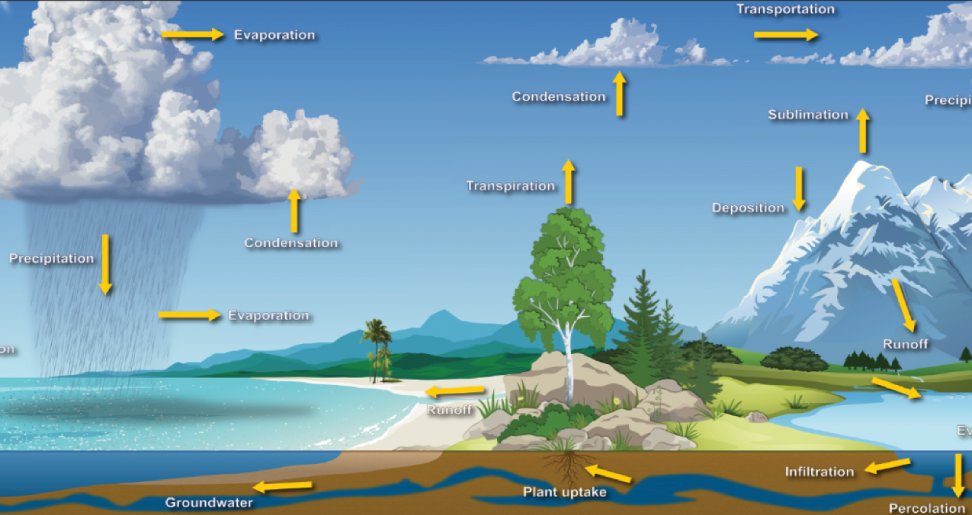The water cycle, also known as the hydrologic cycle, is a continuous process that describes the movement of water on, above, and below the Earth’s surface. It is a fundamental process that sustains life and shapes our planet’s landscapes. This intricate cycle involves various stages, each playing a crucial role in maintaining the delicate balance of Earth’s water resources.
The Stages of the Water Cycle
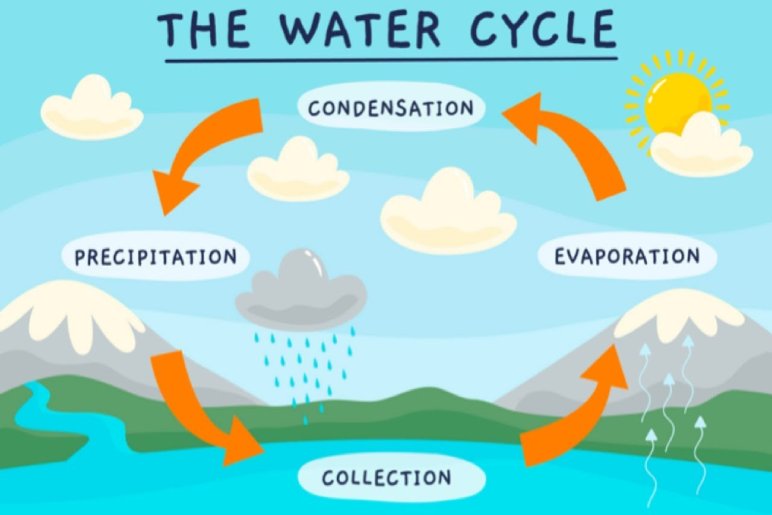
1. Evaporation: The cycle begins with evaporation, the process by which liquid water transforms into water vapor. This occurs when water is heated by the sun’s energy, causing the molecules to gain enough kinetic energy to escape as a gas. The majority of evaporation takes place from oceans, lakes, rivers, and wet soil.
2. Transpiration: Plants also contribute to the water cycle through transpiration. This process involves the release of water vapor into the atmosphere through tiny pores on plant leaves called stomata. Transpiration helps to pull water up from the roots to the leaves, aiding in nutrient transport and cooling the plant.
3. Evapotranspiration: The combined process of evaporation and transpiration is known as evapotranspiration. It is a significant factor in the overall water cycle, as it represents the total amount of water vapor added to the atmosphere from a particular area.
4. Condensation: As water vapor rises into the atmosphere, it cools and condenses into tiny liquid water droplets. These droplets form clouds, which are visible masses of condensed water vapor. Different types of clouds form depending on temperature and atmospheric conditions.
5. Precipitation: When the water droplets in clouds become heavy enough, they fall back to the Earth’s surface as precipitation. Precipitation can take various forms, including rain, snow, sleet, and hail. The type of precipitation depends on atmospheric temperature and conditions.
6. Infiltration: A portion of the precipitation that reaches the ground infiltrates into the soil. This process is known as infiltration. The rate of infiltration depends on factors such as soil type, vegetation cover, and the intensity of rainfall. Infiltrated water can either be absorbed by plants or percolate deeper into the ground to replenish groundwater.
7. Runoff: When the ground is saturated or the rainfall intensity exceeds the infiltration capacity, the excess water flows over the land surface as runoff. Runoff can collect in streams, rivers, lakes, and eventually find its way back to the ocean, completing the cycle.
8. Groundwater Flow: Groundwater is water stored beneath the Earth’s surface in porous rock formations called aquifers. It can slowly move through underground layers and eventually discharge into rivers, lakes, or oceans, contributing to the water cycle.
The Importance of the Water Cycle
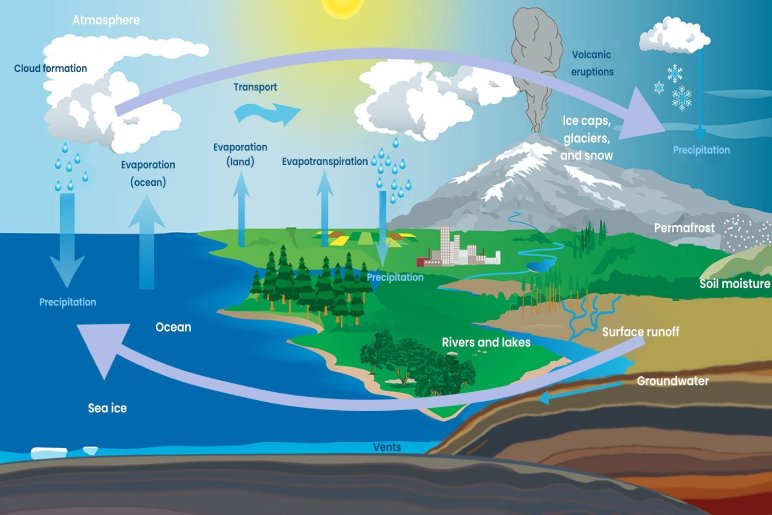
The water cycle is an indispensable process that sustains life on Earth.
This intricate system involves the continuous movement of water between the atmosphere, land, and oceans. Through evaporation, transpiration, condensation, precipitation, and runoff, water is recycled, ensuring a constant supply for all living beings. It regulates climate patterns, replenishes freshwater sources, and supports diverse ecosystems. Moreover, the water cycle plays a pivotal role in human activities, providing water for agriculture, industry, and domestic use. Without this ceaseless circulation, our planet would be an arid and lifeless place.
The Water Cycle and Climate Change
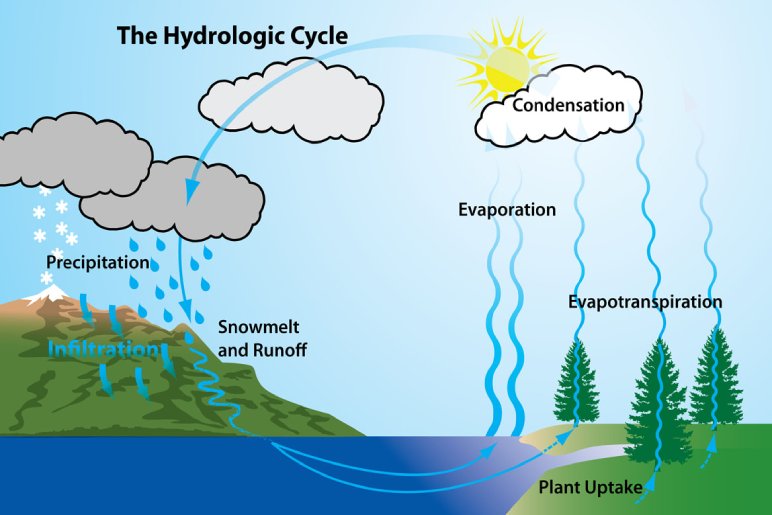
Climate change is profoundly altering the intricate ballet of the water cycle.
As global temperatures rise, evaporation accelerates, leading to more water vapor in the atmosphere. This intensified water cycle manifests in extreme weather events – torrential downpours causing floods in some regions, while prolonged droughts grip others. Melting glaciers and ice caps contribute to rising sea levels, inundating coastal areas. Moreover, altered precipitation patterns disrupt ecosystems, affecting agriculture, water availability, and biodiversity. The delicate equilibrium of the water cycle, essential for life on Earth, is under threat as our planet warms, necessitating urgent adaptation and mitigation strategies.
How the Water Cycle Affects Your Health
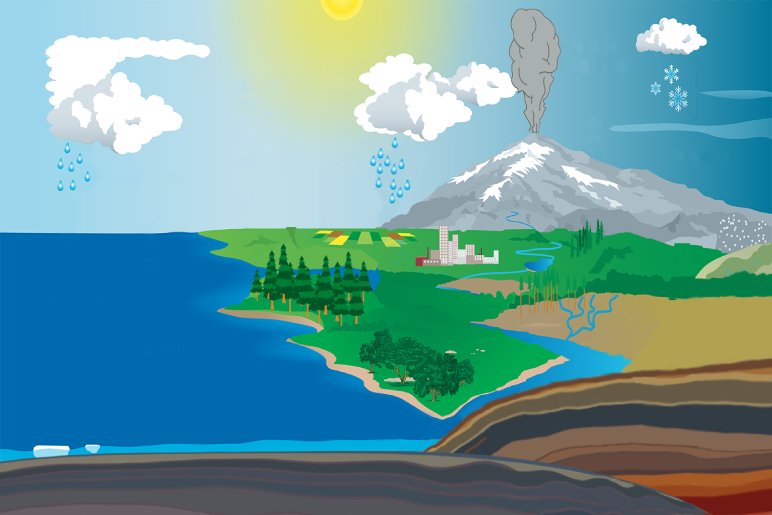
We often think of the water cycle as a distant, natural process, but it’s intimately connected to our health in ways we might not realize. From the water we drink to the air we breathe, the water cycle plays a crucial role in our well-being.
Water Quality and Human Health
- Drinking Water: The most obvious connection is the water we consume. Clean, safe drinking water is essential for preventing waterborne diseases. The water cycle ensures the replenishment of freshwater sources, but human activities can contaminate this resource. Pollution, improper waste disposal, and climate change can disrupt the water cycle, leading to water scarcity and contamination.
- Hygiene: Water is vital for maintaining personal hygiene. Washing hands, bathing, and cleaning our surroundings help prevent the spread of diseases. Adequate access to clean water is crucial for public health.
- Food Production: Agriculture relies heavily on water. The quality of the water used for irrigation directly impacts the safety of our food. Contaminated water can lead to foodborne illnesses.
Air Quality and Human Health
- Evaporation and Condensation: The water cycle influences air quality. Evaporation of water from oceans, lakes, and rivers adds moisture to the atmosphere. This moisture plays a role in cloud formation, which helps regulate temperature and precipitation.
- Climate Regulation: The water cycle helps regulate Earth’s climate. Changes in the water cycle, such as altered precipitation patterns or increased evaporation, can impact weather extremes like droughts, floods, and heatwaves, which in turn affect human health.
Water-Related Diseases
- Waterborne Diseases: Consuming contaminated water can lead to various diseases like cholera, typhoid, and dysentery.
- Vector-Borne Diseases: The water cycle can influence the spread of diseases transmitted by mosquitoes and other insects. For example, stagnant water can provide breeding grounds for mosquitoes, increasing the risk of malaria, dengue, and Zika.
Water Cycle Safety: Navigating Nature’s Flow
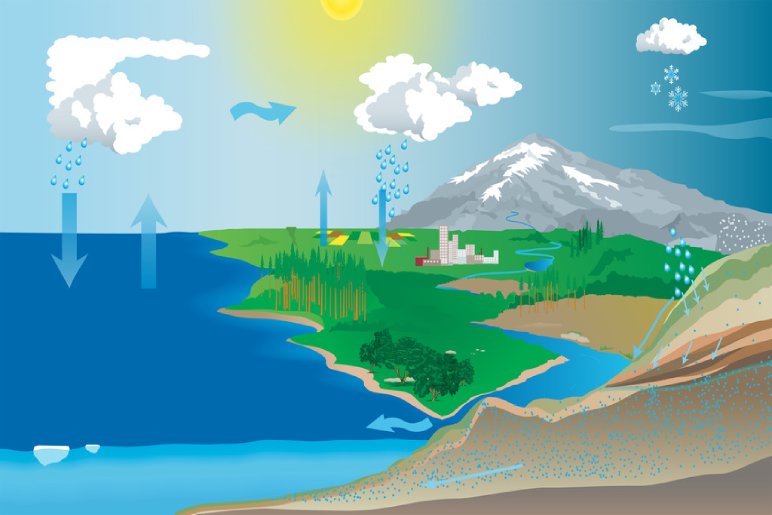
The water cycle, a mesmerizing dance of evaporation, condensation, precipitation, and collection, sustains life on Earth. While this natural process is essential, it also presents potential safety challenges. Let’s explore some tips to help you navigate this vital cycle safely:
Understanding the Risks
Flash Floods: Rapidly rising water levels can be deadly. Avoid low-lying areas during heavy rainfall.
Waterborne Diseases: Contaminated water can harbor harmful bacteria. Practice proper hygiene and avoid consuming untreated water.
Drowning: Open water bodies can be dangerous. Always supervise children near water and wear life jackets when boating or swimming.
Slip and Falls: Wet surfaces can be slippery. Wear appropriate footwear and be cautious on walkways and stairs during rain.
Safety Precautions
Stay Informed: Monitor weather forecasts and heed warnings about flash floods, thunderstorms, and heavy rainfall.
Prepare Your Home: Install gutters, downspouts, and drainage systems to manage rainwater effectively.
Protect Yourself: Wear waterproof clothing and footwear when outdoors during heavy rain.
Be Water Wise: Conserve water to reduce strain on the water cycle and minimize potential risks.
Educate Others: Share water safety tips with family, friends, and community members.
Enjoying the Water Cycle Safely
The water cycle is a vital part of our planet. By understanding the potential risks and taking necessary precautions, you can enjoy its beauty while staying safe. Remember, knowledge is power when it comes to protecting yourself and others from water-related hazards.
Water Cycle FAQs:
The sun’s energy is crucial for driving the water cycle.
It provides the heat needed for evaporation, which is the first step in the process.
The water cycle plays a significant role in weather patterns.
Processes like evaporation, condensation, and precipitation are directly linked to temperature, humidity, and rainfall.
Yes, human activities can significantly impact the water cycle.
Deforestation, pollution, and climate change can alter evaporation rates, precipitation patterns, and water availability.
The water cycle is essential for life on Earth.
It ensures a continuous supply of fresh water for plants, animals, and humans. It also helps regulate the Earth’s climate.
We can conserve water by reducing our water usage, fixing leaks, using water-efficient appliances, and adopting sustainable practices like rainwater harvesting.
Read More:
- Motion of the Ocean: Introduction to Wave Energy
- Managing Your Green Lifestyle: Practical Tips for a Sustainable You
- 5 Ways to Give Your Old Smartphone a New Life: Responsible Recycling Options
Featured Image Source: https://tinyurl.com/2eazwzz2

